Business Market vs. Consumer Market
VerifiedAdded on 2020/06/05
|10
|2622
|74
AI Summary
This assignment delves into the characteristics and dynamics of both business and consumer markets. It analyzes how businesses operate within a market environment, comparing their strategies to those employed in the consumer market. The report emphasizes that while distinct, both types of markets share fundamental principles related to needs assessment, product or service offerings, and customer engagement.
Contribute Materials
Your contribution can guide someone’s learning journey. Share your
documents today.

PRINCIPLES OF BUSINESS
Secure Best Marks with AI Grader
Need help grading? Try our AI Grader for instant feedback on your assignments.
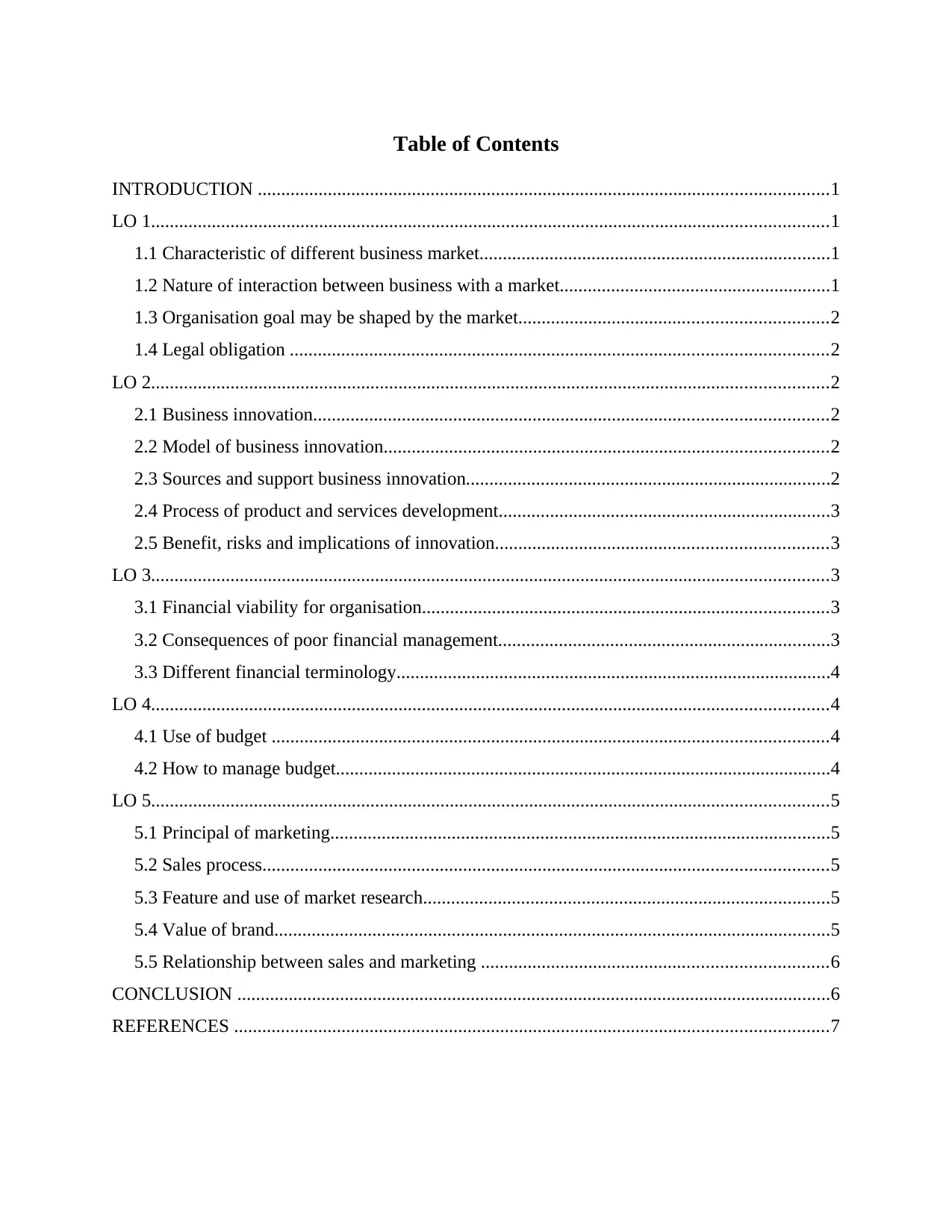
Table of Contents
INTRODUCTION ..........................................................................................................................1
LO 1.................................................................................................................................................1
1.1 Characteristic of different business market...........................................................................1
1.2 Nature of interaction between business with a market..........................................................1
1.3 Organisation goal may be shaped by the market..................................................................2
1.4 Legal obligation ...................................................................................................................2
LO 2.................................................................................................................................................2
2.1 Business innovation..............................................................................................................2
2.2 Model of business innovation...............................................................................................2
2.3 Sources and support business innovation..............................................................................2
2.4 Process of product and services development.......................................................................3
2.5 Benefit, risks and implications of innovation.......................................................................3
LO 3.................................................................................................................................................3
3.1 Financial viability for organisation.......................................................................................3
3.2 Consequences of poor financial management.......................................................................3
3.3 Different financial terminology.............................................................................................4
LO 4.................................................................................................................................................4
4.1 Use of budget .......................................................................................................................4
4.2 How to manage budget..........................................................................................................4
LO 5.................................................................................................................................................5
5.1 Principal of marketing...........................................................................................................5
5.2 Sales process.........................................................................................................................5
5.3 Feature and use of market research.......................................................................................5
5.4 Value of brand.......................................................................................................................5
5.5 Relationship between sales and marketing ..........................................................................6
CONCLUSION ...............................................................................................................................6
REFERENCES ...............................................................................................................................7
INTRODUCTION ..........................................................................................................................1
LO 1.................................................................................................................................................1
1.1 Characteristic of different business market...........................................................................1
1.2 Nature of interaction between business with a market..........................................................1
1.3 Organisation goal may be shaped by the market..................................................................2
1.4 Legal obligation ...................................................................................................................2
LO 2.................................................................................................................................................2
2.1 Business innovation..............................................................................................................2
2.2 Model of business innovation...............................................................................................2
2.3 Sources and support business innovation..............................................................................2
2.4 Process of product and services development.......................................................................3
2.5 Benefit, risks and implications of innovation.......................................................................3
LO 3.................................................................................................................................................3
3.1 Financial viability for organisation.......................................................................................3
3.2 Consequences of poor financial management.......................................................................3
3.3 Different financial terminology.............................................................................................4
LO 4.................................................................................................................................................4
4.1 Use of budget .......................................................................................................................4
4.2 How to manage budget..........................................................................................................4
LO 5.................................................................................................................................................5
5.1 Principal of marketing...........................................................................................................5
5.2 Sales process.........................................................................................................................5
5.3 Feature and use of market research.......................................................................................5
5.4 Value of brand.......................................................................................................................5
5.5 Relationship between sales and marketing ..........................................................................6
CONCLUSION ...............................................................................................................................6
REFERENCES ...............................................................................................................................7

INTRODUCTION
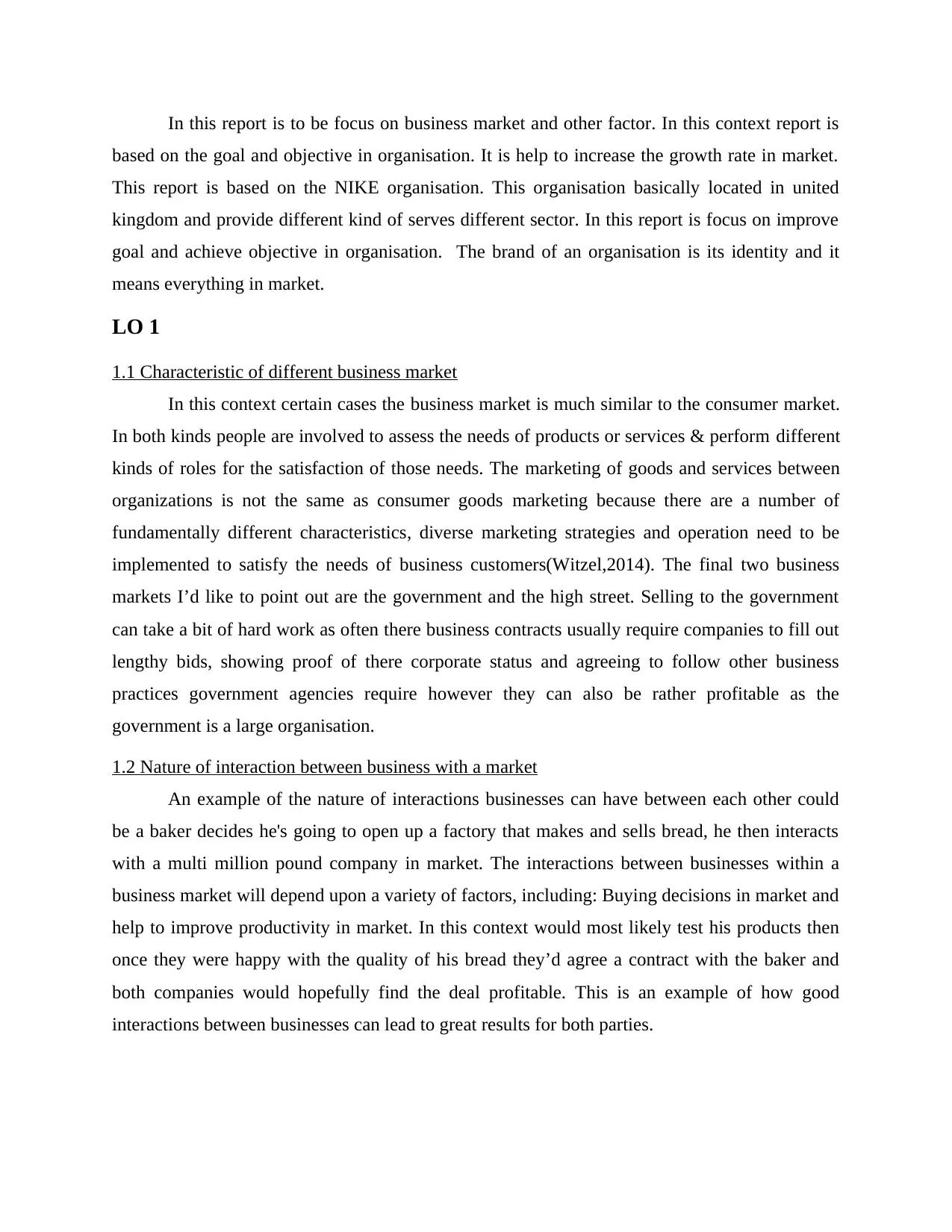
In this report is to be focus on business market and other factor. In this context report is
based on the goal and objective in organisation. It is help to increase the growth rate in market.
This report is based on the NIKE organisation. This organisation basically located in united
kingdom and provide different kind of serves different sector. In this report is focus on improve
goal and achieve objective in organisation. The brand of an organisation is its identity and it
means everything in market.
LO 1
1.1 Characteristic of different business market
In this context certain cases the business market is much similar to the consumer market.
In both kinds people are involved to assess the needs of products or services & perform different
kinds of roles for the satisfaction of those needs. The marketing of goods and services between
organizations is not the same as consumer goods marketing because there are a number of
fundamentally different characteristics, diverse marketing strategies and operation need to be
implemented to satisfy the needs of business customers(Witzel,2014). The final two business
markets I’d like to point out are the government and the high street. Selling to the government
can take a bit of hard work as often there business contracts usually require companies to fill out
lengthy bids, showing proof of there corporate status and agreeing to follow other business
practices government agencies require however they can also be rather profitable as the
government is a large organisation.
1.2 Nature of interaction between business with a market
An example of the nature of interactions businesses can have between each other could
be a baker decides he's going to open up a factory that makes and sells bread, he then interacts
with a multi million pound company in market. The interactions between businesses within a
business market will depend upon a variety of factors, including: Buying decisions in market and
help to improve productivity in market. In this context would most likely test his products then
once they were happy with the quality of his bread they’d agree a contract with the baker and
both companies would hopefully find the deal profitable. This is an example of how good
interactions between businesses can lead to great results for both parties.
based on the goal and objective in organisation. It is help to increase the growth rate in market.
This report is based on the NIKE organisation. This organisation basically located in united
kingdom and provide different kind of serves different sector. In this report is focus on improve
goal and achieve objective in organisation. The brand of an organisation is its identity and it
means everything in market.
LO 1
1.1 Characteristic of different business market
In this context certain cases the business market is much similar to the consumer market.
In both kinds people are involved to assess the needs of products or services & perform different
kinds of roles for the satisfaction of those needs. The marketing of goods and services between
organizations is not the same as consumer goods marketing because there are a number of
fundamentally different characteristics, diverse marketing strategies and operation need to be
implemented to satisfy the needs of business customers(Witzel,2014). The final two business
markets I’d like to point out are the government and the high street. Selling to the government
can take a bit of hard work as often there business contracts usually require companies to fill out
lengthy bids, showing proof of there corporate status and agreeing to follow other business
practices government agencies require however they can also be rather profitable as the
government is a large organisation.
1.2 Nature of interaction between business with a market
An example of the nature of interactions businesses can have between each other could
be a baker decides he's going to open up a factory that makes and sells bread, he then interacts
with a multi million pound company in market. The interactions between businesses within a
business market will depend upon a variety of factors, including: Buying decisions in market and
help to improve productivity in market. In this context would most likely test his products then
once they were happy with the quality of his bread they’d agree a contract with the baker and
both companies would hopefully find the deal profitable. This is an example of how good
interactions between businesses can lead to great results for both parties.
Secure Best Marks with AI Grader
Need help grading? Try our AI Grader for instant feedback on your assignments.
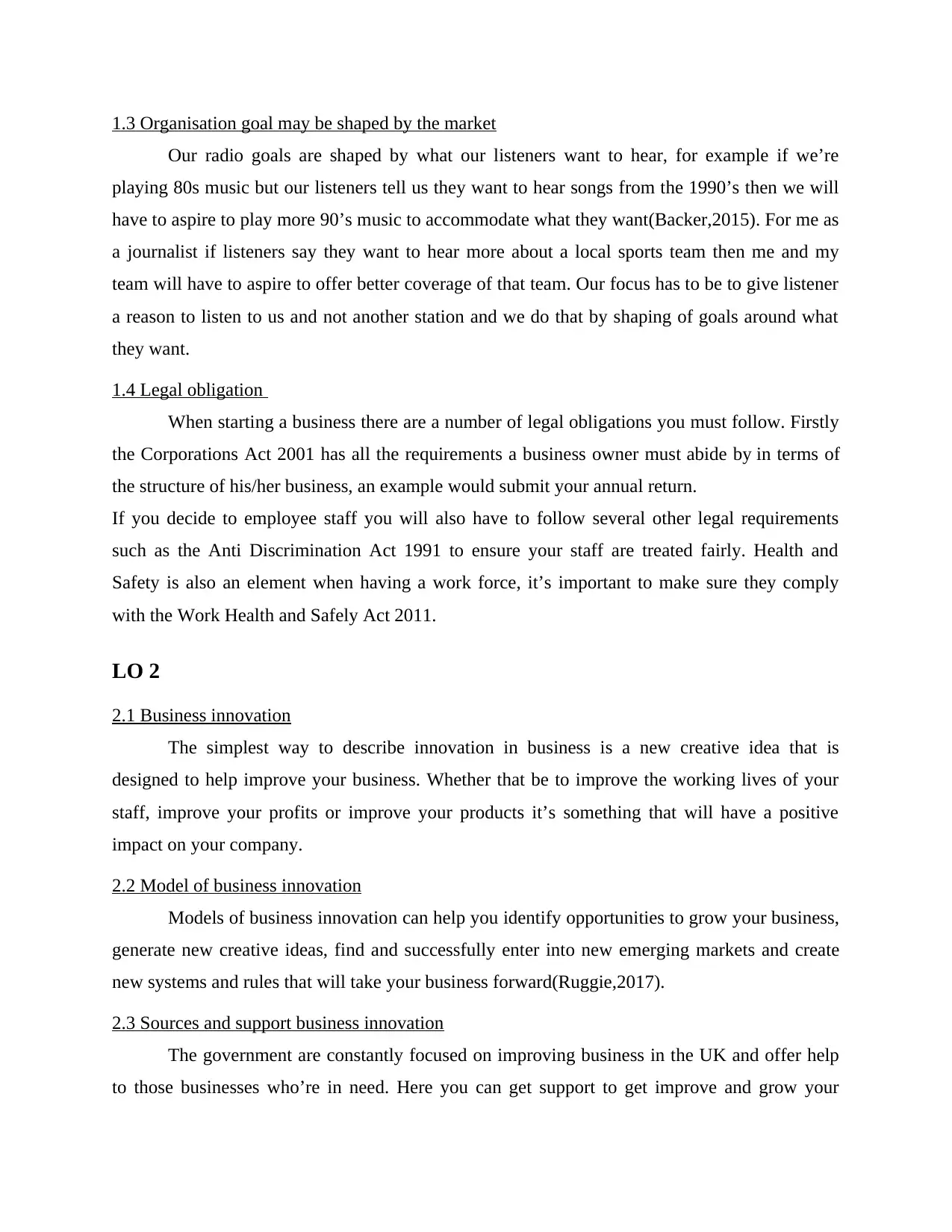
1.3 Organisation goal may be shaped by the market
Our radio goals are shaped by what our listeners want to hear, for example if we’re
playing 80s music but our listeners tell us they want to hear songs from the 1990’s then we will
have to aspire to play more 90’s music to accommodate what they want(Backer,2015). For me as
a journalist if listeners say they want to hear more about a local sports team then me and my
team will have to aspire to offer better coverage of that team. Our focus has to be to give listener
a reason to listen to us and not another station and we do that by shaping of goals around what
they want.
1.4 Legal obligation
When starting a business there are a number of legal obligations you must follow. Firstly
the Corporations Act 2001 has all the requirements a business owner must abide by in terms of
the structure of his/her business, an example would submit your annual return.
If you decide to employee staff you will also have to follow several other legal requirements
such as the Anti Discrimination Act 1991 to ensure your staff are treated fairly. Health and
Safety is also an element when having a work force, it’s important to make sure they comply
with the Work Health and Safely Act 2011.
LO 2
2.1 Business innovation
The simplest way to describe innovation in business is a new creative idea that is
designed to help improve your business. Whether that be to improve the working lives of your
staff, improve your profits or improve your products it’s something that will have a positive
impact on your company.
2.2 Model of business innovation
Models of business innovation can help you identify opportunities to grow your business,
generate new creative ideas, find and successfully enter into new emerging markets and create
new systems and rules that will take your business forward(Ruggie,2017).
2.3 Sources and support business innovation
The government are constantly focused on improving business in the UK and offer help
to those businesses who’re in need. Here you can get support to get improve and grow your
Our radio goals are shaped by what our listeners want to hear, for example if we’re
playing 80s music but our listeners tell us they want to hear songs from the 1990’s then we will
have to aspire to play more 90’s music to accommodate what they want(Backer,2015). For me as
a journalist if listeners say they want to hear more about a local sports team then me and my
team will have to aspire to offer better coverage of that team. Our focus has to be to give listener
a reason to listen to us and not another station and we do that by shaping of goals around what
they want.
1.4 Legal obligation
When starting a business there are a number of legal obligations you must follow. Firstly
the Corporations Act 2001 has all the requirements a business owner must abide by in terms of
the structure of his/her business, an example would submit your annual return.
If you decide to employee staff you will also have to follow several other legal requirements
such as the Anti Discrimination Act 1991 to ensure your staff are treated fairly. Health and
Safety is also an element when having a work force, it’s important to make sure they comply
with the Work Health and Safely Act 2011.
LO 2
2.1 Business innovation
The simplest way to describe innovation in business is a new creative idea that is
designed to help improve your business. Whether that be to improve the working lives of your
staff, improve your profits or improve your products it’s something that will have a positive
impact on your company.
2.2 Model of business innovation
Models of business innovation can help you identify opportunities to grow your business,
generate new creative ideas, find and successfully enter into new emerging markets and create
new systems and rules that will take your business forward(Ruggie,2017).
2.3 Sources and support business innovation
The government are constantly focused on improving business in the UK and offer help
to those businesses who’re in need. Here you can get support to get improve and grow your
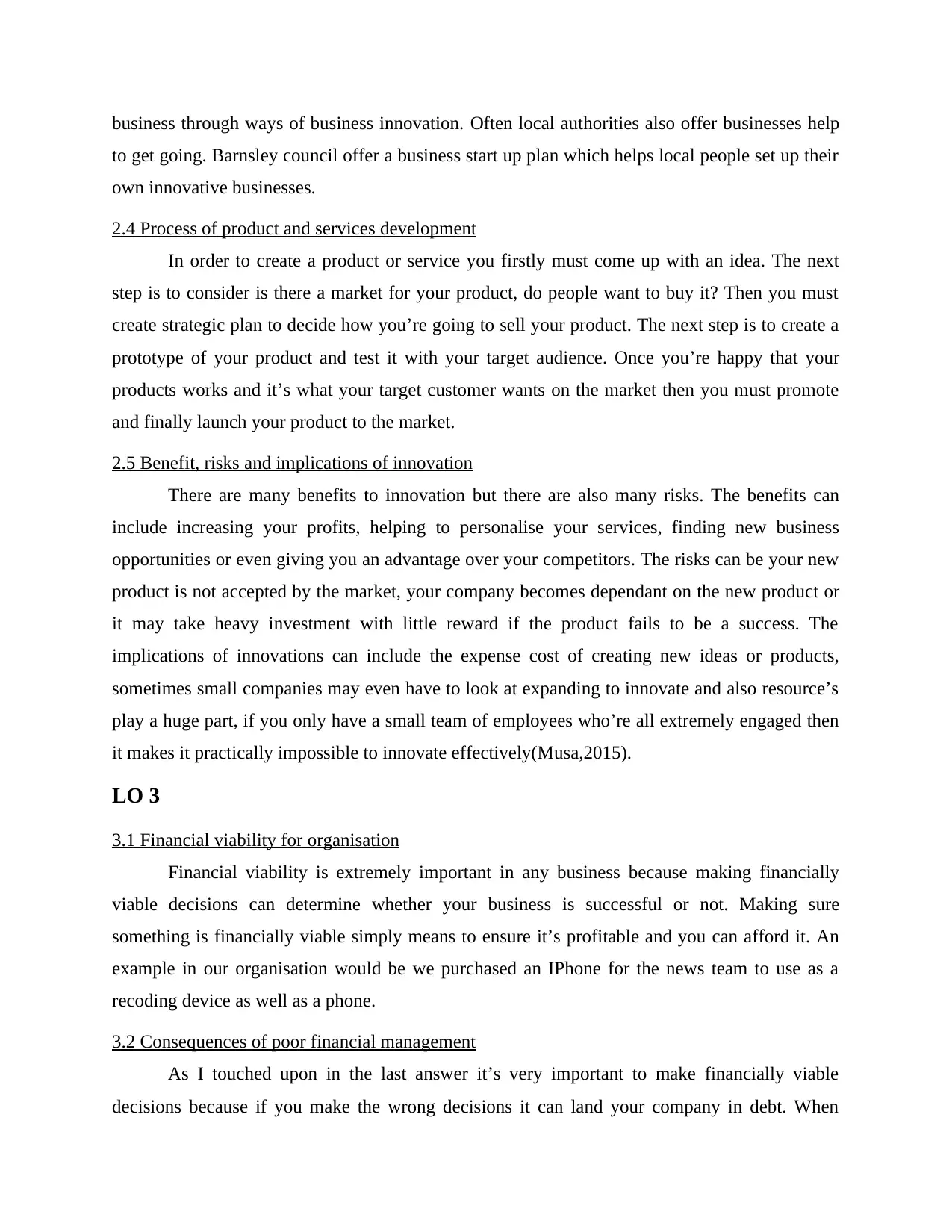
business through ways of business innovation. Often local authorities also offer businesses help
to get going. Barnsley council offer a business start up plan which helps local people set up their
own innovative businesses.
2.4 Process of product and services development
In order to create a product or service you firstly must come up with an idea. The next
step is to consider is there a market for your product, do people want to buy it? Then you must
create strategic plan to decide how you’re going to sell your product. The next step is to create a
prototype of your product and test it with your target audience. Once you’re happy that your
products works and it’s what your target customer wants on the market then you must promote
and finally launch your product to the market.
2.5 Benefit, risks and implications of innovation
There are many benefits to innovation but there are also many risks. The benefits can
include increasing your profits, helping to personalise your services, finding new business
opportunities or even giving you an advantage over your competitors. The risks can be your new
product is not accepted by the market, your company becomes dependant on the new product or
it may take heavy investment with little reward if the product fails to be a success. The
implications of innovations can include the expense cost of creating new ideas or products,
sometimes small companies may even have to look at expanding to innovate and also resource’s
play a huge part, if you only have a small team of employees who’re all extremely engaged then
it makes it practically impossible to innovate effectively(Musa,2015).
LO 3
3.1 Financial viability for organisation
Financial viability is extremely important in any business because making financially
viable decisions can determine whether your business is successful or not. Making sure
something is financially viable simply means to ensure it’s profitable and you can afford it. An
example in our organisation would be we purchased an IPhone for the news team to use as a
recoding device as well as a phone.
3.2 Consequences of poor financial management
As I touched upon in the last answer it’s very important to make financially viable
decisions because if you make the wrong decisions it can land your company in debt. When
to get going. Barnsley council offer a business start up plan which helps local people set up their
own innovative businesses.
2.4 Process of product and services development
In order to create a product or service you firstly must come up with an idea. The next
step is to consider is there a market for your product, do people want to buy it? Then you must
create strategic plan to decide how you’re going to sell your product. The next step is to create a
prototype of your product and test it with your target audience. Once you’re happy that your
products works and it’s what your target customer wants on the market then you must promote
and finally launch your product to the market.
2.5 Benefit, risks and implications of innovation
There are many benefits to innovation but there are also many risks. The benefits can
include increasing your profits, helping to personalise your services, finding new business
opportunities or even giving you an advantage over your competitors. The risks can be your new
product is not accepted by the market, your company becomes dependant on the new product or
it may take heavy investment with little reward if the product fails to be a success. The
implications of innovations can include the expense cost of creating new ideas or products,
sometimes small companies may even have to look at expanding to innovate and also resource’s
play a huge part, if you only have a small team of employees who’re all extremely engaged then
it makes it practically impossible to innovate effectively(Musa,2015).
LO 3
3.1 Financial viability for organisation
Financial viability is extremely important in any business because making financially
viable decisions can determine whether your business is successful or not. Making sure
something is financially viable simply means to ensure it’s profitable and you can afford it. An
example in our organisation would be we purchased an IPhone for the news team to use as a
recoding device as well as a phone.
3.2 Consequences of poor financial management
As I touched upon in the last answer it’s very important to make financially viable
decisions because if you make the wrong decisions it can land your company in debt. When
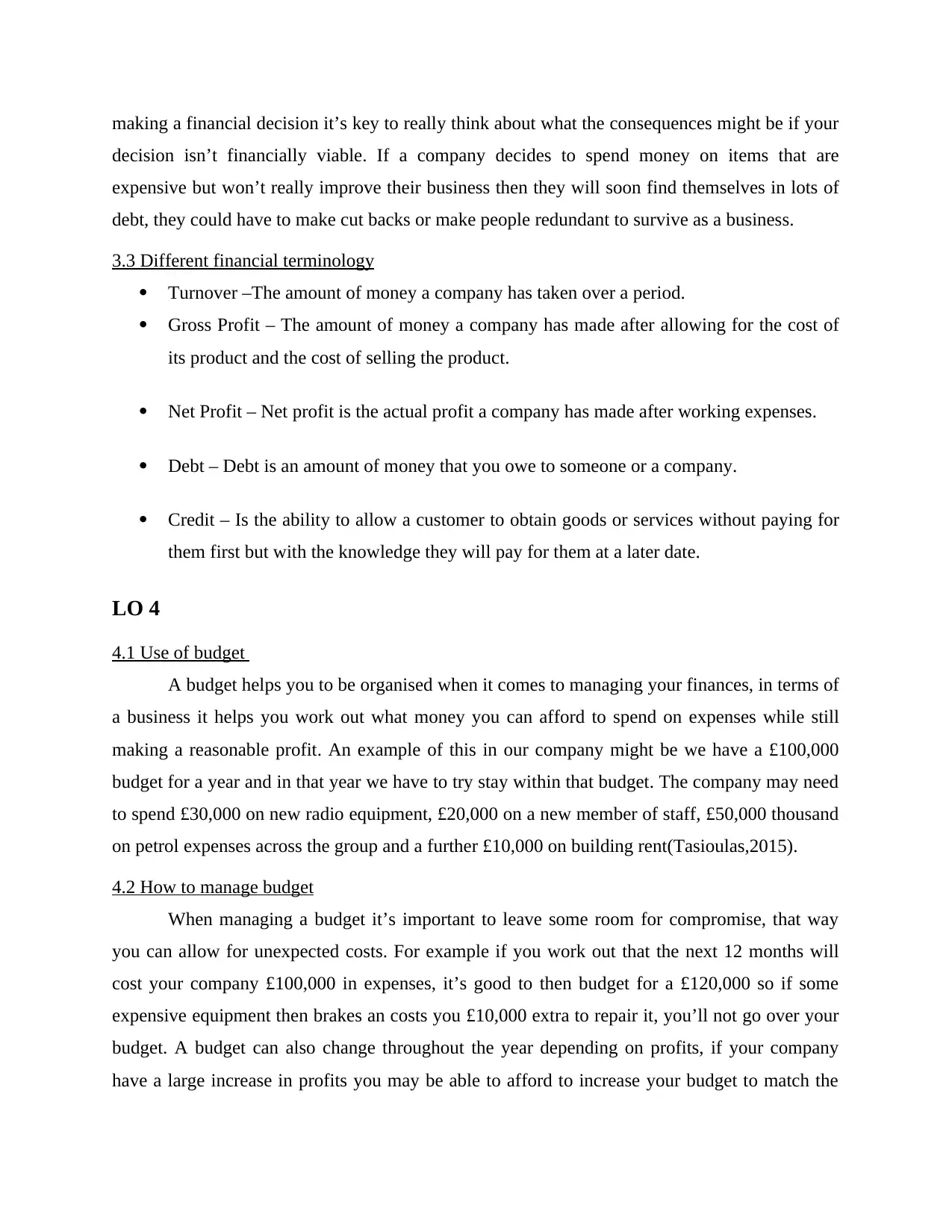
making a financial decision it’s key to really think about what the consequences might be if your
decision isn’t financially viable. If a company decides to spend money on items that are
expensive but won’t really improve their business then they will soon find themselves in lots of
debt, they could have to make cut backs or make people redundant to survive as a business.
3.3 Different financial terminology
Turnover –The amount of money a company has taken over a period.
Gross Profit – The amount of money a company has made after allowing for the cost of
its product and the cost of selling the product.
Net Profit – Net profit is the actual profit a company has made after working expenses.
Debt – Debt is an amount of money that you owe to someone or a company.
Credit – Is the ability to allow a customer to obtain goods or services without paying for
them first but with the knowledge they will pay for them at a later date.
LO 4
4.1 Use of budget
A budget helps you to be organised when it comes to managing your finances, in terms of
a business it helps you work out what money you can afford to spend on expenses while still
making a reasonable profit. An example of this in our company might be we have a £100,000
budget for a year and in that year we have to try stay within that budget. The company may need
to spend £30,000 on new radio equipment, £20,000 on a new member of staff, £50,000 thousand
on petrol expenses across the group and a further £10,000 on building rent(Tasioulas,2015).
4.2 How to manage budget
When managing a budget it’s important to leave some room for compromise, that way
you can allow for unexpected costs. For example if you work out that the next 12 months will
cost your company £100,000 in expenses, it’s good to then budget for a £120,000 so if some
expensive equipment then brakes an costs you £10,000 extra to repair it, you’ll not go over your
budget. A budget can also change throughout the year depending on profits, if your company
have a large increase in profits you may be able to afford to increase your budget to match the
decision isn’t financially viable. If a company decides to spend money on items that are
expensive but won’t really improve their business then they will soon find themselves in lots of
debt, they could have to make cut backs or make people redundant to survive as a business.
3.3 Different financial terminology
Turnover –The amount of money a company has taken over a period.
Gross Profit – The amount of money a company has made after allowing for the cost of
its product and the cost of selling the product.
Net Profit – Net profit is the actual profit a company has made after working expenses.
Debt – Debt is an amount of money that you owe to someone or a company.
Credit – Is the ability to allow a customer to obtain goods or services without paying for
them first but with the knowledge they will pay for them at a later date.
LO 4
4.1 Use of budget
A budget helps you to be organised when it comes to managing your finances, in terms of
a business it helps you work out what money you can afford to spend on expenses while still
making a reasonable profit. An example of this in our company might be we have a £100,000
budget for a year and in that year we have to try stay within that budget. The company may need
to spend £30,000 on new radio equipment, £20,000 on a new member of staff, £50,000 thousand
on petrol expenses across the group and a further £10,000 on building rent(Tasioulas,2015).
4.2 How to manage budget
When managing a budget it’s important to leave some room for compromise, that way
you can allow for unexpected costs. For example if you work out that the next 12 months will
cost your company £100,000 in expenses, it’s good to then budget for a £120,000 so if some
expensive equipment then brakes an costs you £10,000 extra to repair it, you’ll not go over your
budget. A budget can also change throughout the year depending on profits, if your company
have a large increase in profits you may be able to afford to increase your budget to match the
Paraphrase This Document
Need a fresh take? Get an instant paraphrase of this document with our AI Paraphraser
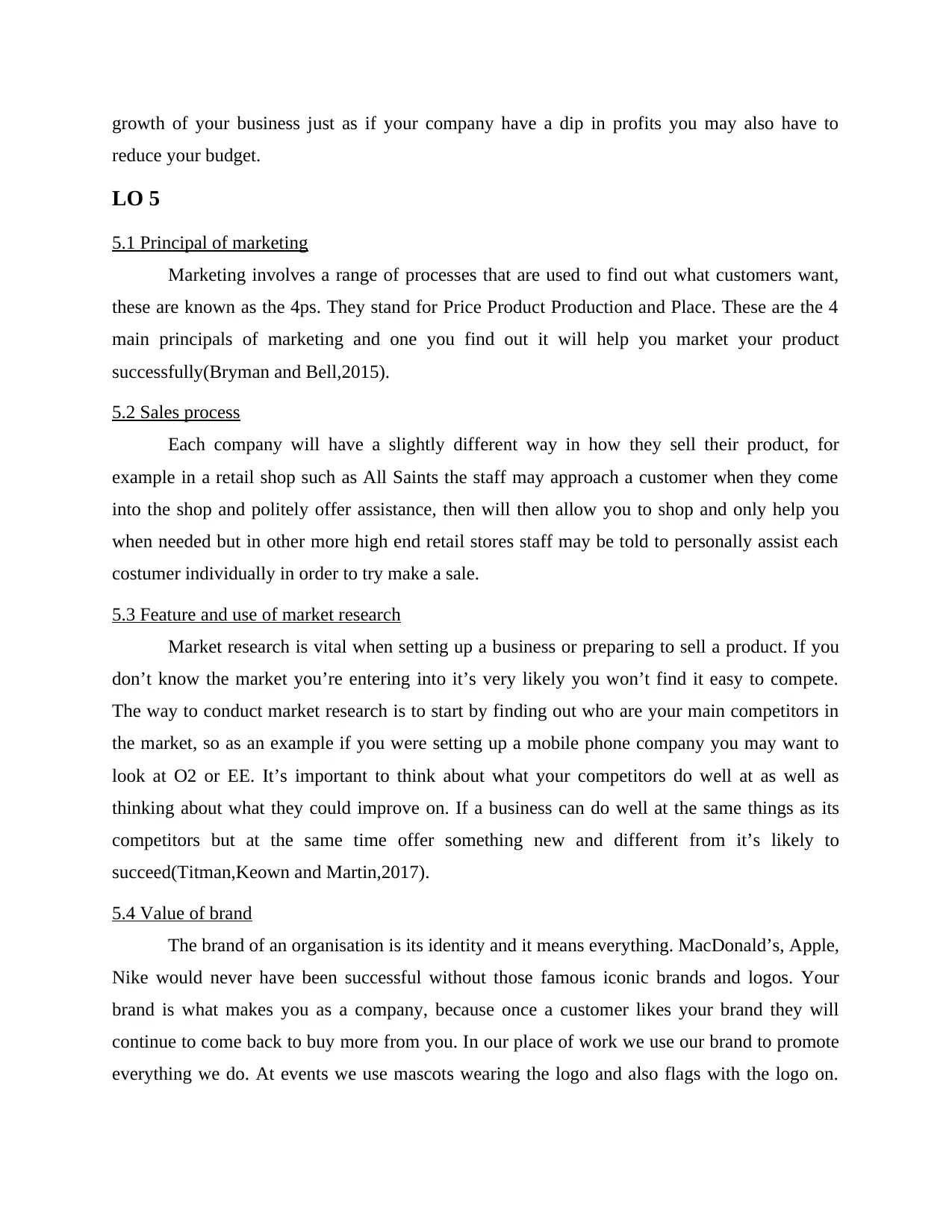
growth of your business just as if your company have a dip in profits you may also have to
reduce your budget.
LO 5
5.1 Principal of marketing
Marketing involves a range of processes that are used to find out what customers want,
these are known as the 4ps. They stand for Price Product Production and Place. These are the 4
main principals of marketing and one you find out it will help you market your product
successfully(Bryman and Bell,2015).
5.2 Sales process
Each company will have a slightly different way in how they sell their product, for
example in a retail shop such as All Saints the staff may approach a customer when they come
into the shop and politely offer assistance, then will then allow you to shop and only help you
when needed but in other more high end retail stores staff may be told to personally assist each
costumer individually in order to try make a sale.
5.3 Feature and use of market research
Market research is vital when setting up a business or preparing to sell a product. If you
don’t know the market you’re entering into it’s very likely you won’t find it easy to compete.
The way to conduct market research is to start by finding out who are your main competitors in
the market, so as an example if you were setting up a mobile phone company you may want to
look at O2 or EE. It’s important to think about what your competitors do well at as well as
thinking about what they could improve on. If a business can do well at the same things as its
competitors but at the same time offer something new and different from it’s likely to
succeed(Titman,Keown and Martin,2017).
5.4 Value of brand
The brand of an organisation is its identity and it means everything. MacDonald’s, Apple,
Nike would never have been successful without those famous iconic brands and logos. Your
brand is what makes you as a company, because once a customer likes your brand they will
continue to come back to buy more from you. In our place of work we use our brand to promote
everything we do. At events we use mascots wearing the logo and also flags with the logo on.
reduce your budget.
LO 5
5.1 Principal of marketing
Marketing involves a range of processes that are used to find out what customers want,
these are known as the 4ps. They stand for Price Product Production and Place. These are the 4
main principals of marketing and one you find out it will help you market your product
successfully(Bryman and Bell,2015).
5.2 Sales process
Each company will have a slightly different way in how they sell their product, for
example in a retail shop such as All Saints the staff may approach a customer when they come
into the shop and politely offer assistance, then will then allow you to shop and only help you
when needed but in other more high end retail stores staff may be told to personally assist each
costumer individually in order to try make a sale.
5.3 Feature and use of market research
Market research is vital when setting up a business or preparing to sell a product. If you
don’t know the market you’re entering into it’s very likely you won’t find it easy to compete.
The way to conduct market research is to start by finding out who are your main competitors in
the market, so as an example if you were setting up a mobile phone company you may want to
look at O2 or EE. It’s important to think about what your competitors do well at as well as
thinking about what they could improve on. If a business can do well at the same things as its
competitors but at the same time offer something new and different from it’s likely to
succeed(Titman,Keown and Martin,2017).
5.4 Value of brand
The brand of an organisation is its identity and it means everything. MacDonald’s, Apple,
Nike would never have been successful without those famous iconic brands and logos. Your
brand is what makes you as a company, because once a customer likes your brand they will
continue to come back to buy more from you. In our place of work we use our brand to promote
everything we do. At events we use mascots wearing the logo and also flags with the logo on.
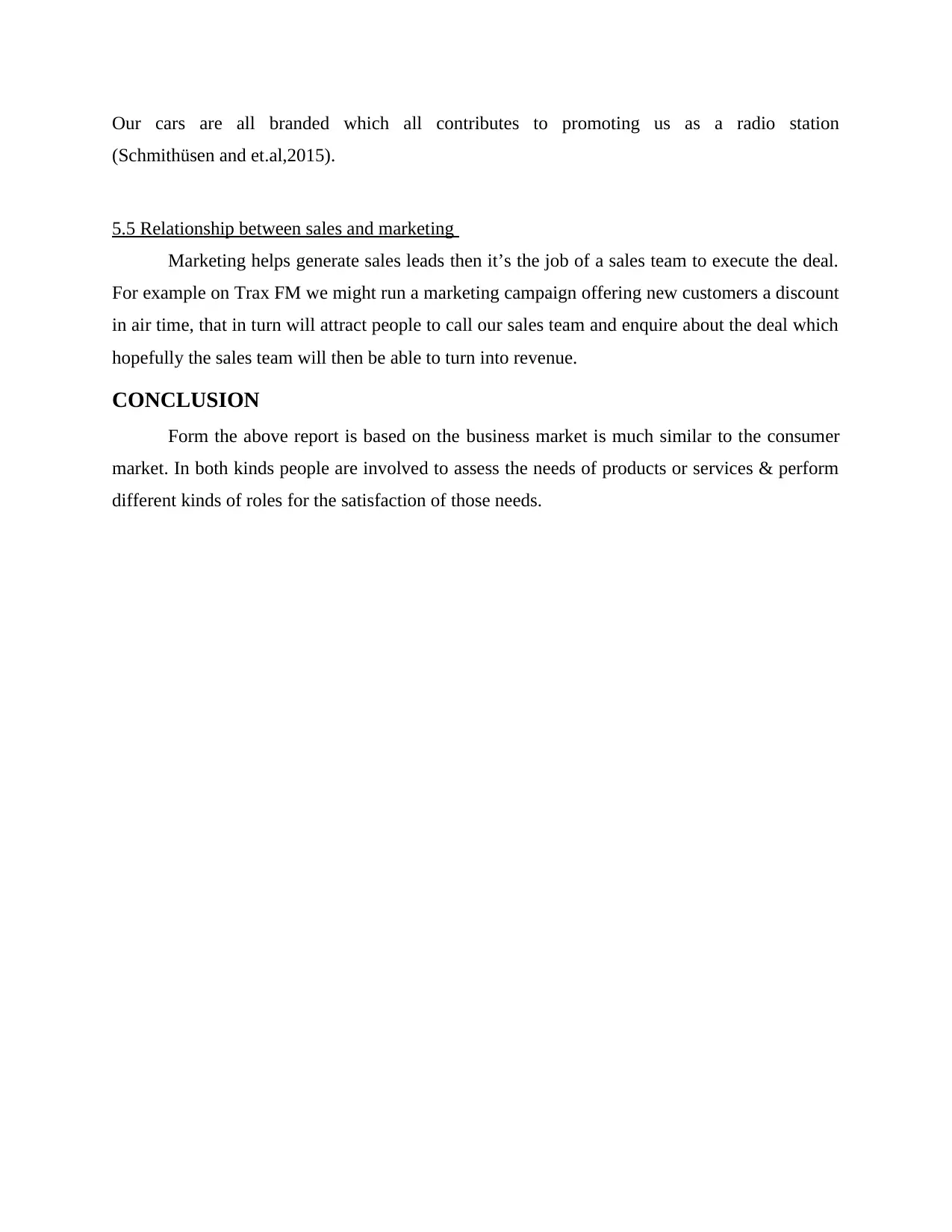
Our cars are all branded which all contributes to promoting us as a radio station
(Schmithüsen and et.al,2015).
5.5 Relationship between sales and marketing
Marketing helps generate sales leads then it’s the job of a sales team to execute the deal.
For example on Trax FM we might run a marketing campaign offering new customers a discount
in air time, that in turn will attract people to call our sales team and enquire about the deal which
hopefully the sales team will then be able to turn into revenue.
CONCLUSION
Form the above report is based on the business market is much similar to the consumer
market. In both kinds people are involved to assess the needs of products or services & perform
different kinds of roles for the satisfaction of those needs.
(Schmithüsen and et.al,2015).
5.5 Relationship between sales and marketing
Marketing helps generate sales leads then it’s the job of a sales team to execute the deal.
For example on Trax FM we might run a marketing campaign offering new customers a discount
in air time, that in turn will attract people to call our sales team and enquire about the deal which
hopefully the sales team will then be able to turn into revenue.
CONCLUSION
Form the above report is based on the business market is much similar to the consumer
market. In both kinds people are involved to assess the needs of products or services & perform
different kinds of roles for the satisfaction of those needs.
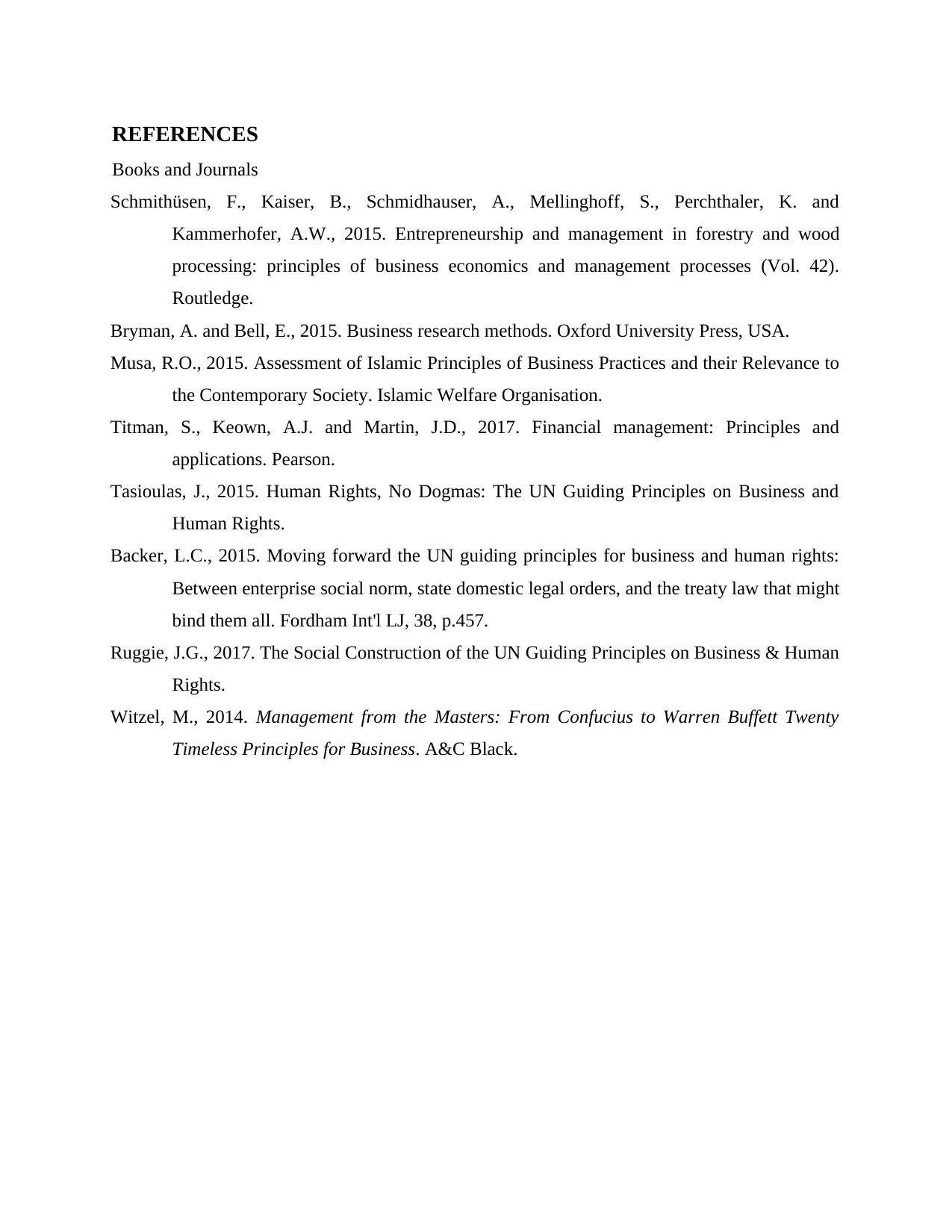
REFERENCES
Books and Journals
Schmithüsen, F., Kaiser, B., Schmidhauser, A., Mellinghoff, S., Perchthaler, K. and
Kammerhofer, A.W., 2015. Entrepreneurship and management in forestry and wood
processing: principles of business economics and management processes (Vol. 42).
Routledge.
Bryman, A. and Bell, E., 2015. Business research methods. Oxford University Press, USA.
Musa, R.O., 2015. Assessment of Islamic Principles of Business Practices and their Relevance to
the Contemporary Society. Islamic Welfare Organisation.
Titman, S., Keown, A.J. and Martin, J.D., 2017. Financial management: Principles and
applications. Pearson.
Tasioulas, J., 2015. Human Rights, No Dogmas: The UN Guiding Principles on Business and
Human Rights.
Backer, L.C., 2015. Moving forward the UN guiding principles for business and human rights:
Between enterprise social norm, state domestic legal orders, and the treaty law that might
bind them all. Fordham Int'l LJ, 38, p.457.
Ruggie, J.G., 2017. The Social Construction of the UN Guiding Principles on Business & Human
Rights.
Witzel, M., 2014. Management from the Masters: From Confucius to Warren Buffett Twenty
Timeless Principles for Business. A&C Black.
Books and Journals
Schmithüsen, F., Kaiser, B., Schmidhauser, A., Mellinghoff, S., Perchthaler, K. and
Kammerhofer, A.W., 2015. Entrepreneurship and management in forestry and wood
processing: principles of business economics and management processes (Vol. 42).
Routledge.
Bryman, A. and Bell, E., 2015. Business research methods. Oxford University Press, USA.
Musa, R.O., 2015. Assessment of Islamic Principles of Business Practices and their Relevance to
the Contemporary Society. Islamic Welfare Organisation.
Titman, S., Keown, A.J. and Martin, J.D., 2017. Financial management: Principles and
applications. Pearson.
Tasioulas, J., 2015. Human Rights, No Dogmas: The UN Guiding Principles on Business and
Human Rights.
Backer, L.C., 2015. Moving forward the UN guiding principles for business and human rights:
Between enterprise social norm, state domestic legal orders, and the treaty law that might
bind them all. Fordham Int'l LJ, 38, p.457.
Ruggie, J.G., 2017. The Social Construction of the UN Guiding Principles on Business & Human
Rights.
Witzel, M., 2014. Management from the Masters: From Confucius to Warren Buffett Twenty
Timeless Principles for Business. A&C Black.
1 out of 10
Related Documents
Your All-in-One AI-Powered Toolkit for Academic Success.
+13062052269
info@desklib.com
Available 24*7 on WhatsApp / Email
![[object Object]](/_next/static/media/star-bottom.7253800d.svg)
Unlock your academic potential
© 2024 | Zucol Services PVT LTD | All rights reserved.





